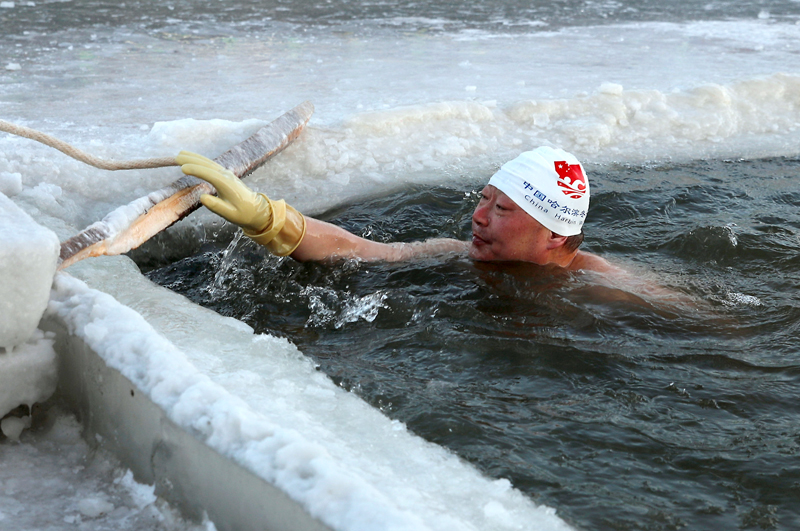The surfaces on which athletes run on can play a large role in determining how well they perform - and how likely they are to get injured. To understand why this is so, it's important to realize that running is essentially a series of collisions between your body and the ground. As your right foot makes impact with the surface on which you are running, the muscles in your right leg contract and reverse the downward velocity of your body, accelerating you upward and forward. Less than a half-second later, as your left foot hits paydirt, the muscles in your left leg contract and turn the tables on your descending acceleration again. These collisions and velocity reversals occur at a high rate - about 180 times per minute for the average runner, or over 37,000 times in all during a three and a-half hour marathon.
Natural springiness
However, in truth much of the velocity turnabout (i.e., the transposition of the downward acceleration of your body into upward and forward movement) which occurs over and over as you run is completed not because of active muscular contractions but as a result of the natural springiness of the muscles, tendons, and ligaments in your legs. For example, as one of your legs moves forward (during the 'swing' phase of the gait cycle), the muscles, tendons, and ligaments on the back side of the leg become stretched (elongated), and when your foot hits the ground they recoil elastically, pushing you up and forward. In addition, your quads stretch elastically once your foot hits the ground; their elastic recoil helps to straighten the leg as you move into toe-off position and begin to bound forward toward the other foot. Your muscles, tendons, and ligaments alternately store and then release elastic energy as you run, and in this sense your legs are 'musculoskeletal springs'.If this is not intuitively obvious, think about the motions involved in running in a slightly different way, and you'll automatically see that your legs perform very much like springs as you run. As one foot hits the ground, the leg attached to that foot compresses as a result of hip, knee, and ankle flexion, just as a real spring becomes more compact when it collides with a solid object. As your foot leaves the ground your leg straightens, just as a real spring would do in its 'recovery phase' following a collision with another object.
So far so good, but what is often forgotten is that the surfaces on which we run are also springs, regardless of their composition. Concrete, of course, behaves as a very stiff (non-compliant) spring when it interacts with human 'leg springs'. Concrete yields only imperceptibly to human tissue, and its spring-like capacity can be observed only when it is dented by a massive object, say a car rushing along at full speed. In contrast, basketball floors, soft tracks, plushy grass, and doughy dirt are much more malleable springs.
Surface springiness and running speed
As you no doubt know, the springiness of a running surface can have a significant effect on the velocity which an endurance runner can sustain during a workout or race. For example, in a study in which human subjects ran at maximum-possible speeds on very hard surfaces and also on experimental running tracks which had a large range of compliances (from medium to soft), the runners slowed down dramatically on the softer surfaces. The researchers determined that foot-contact time (i.e., the duration of the stance phase of the gait cycle) was almost three times as long on the more compliant surfaces, compared to the hard ones, which of course retarded the runners' paces fairly drastically ('The Influence of Track Compliance on Running', Journal of Biomechanics, vol. 12, pp. 893-904, 1979).What was happening, of course, was that the more compliant surfaces were acting like mushy springs, storing the energy associated with collision (footstrike) by compressing themselves - and releasing the energy back to the runner somewhat slowly as their soft materials 'decompressed'. In effect, the runners feet were riding up and down on the gooey surfaces (their feet went down as the surfaces flattened and rode back up again as the goo slowly sprang back). This, of course, was quite different from what happened on cement, from which the runners' feet bounced away nearly instantly. Since the runners spent more time on the ground when they ran on softer surfaces, compared to hard ones, they slowed down whenever they ran on anything which was fairly jellylike.
Between iron and cooked spaghetti
One of the obvious lessons of this research is that anything which significantly changes the spring stiffness of the surface on which we run will also change our ability to run at high speed. However, the often-overlooked lesson is that anything which significantly alters the spring stiffness of our legs may also have an effect on velocity - by changing the contact time between our legs and the running surface. This means that there must be an optimal leg stiffness to produce the best-possible race velocity, or perhaps a small range of optimal stiffnesses. If your legs are like limp spaghetti, contact time will be too expansive and running speed will slow. At the other end of the spectrum, if your legs are like iron posts, contact time will be minimized but stride length will suffer unacceptably because there is too little stored energy in the legs (too-stiff legs can't have nicely stretched muscles and connective tissues and thus can't rely on elastic recoil of tissues to expand stride length). Somewhere between iron and cooked spaghetti, your legs will have the right stiffness. To make things a little 'harder' for you, that correct stiffness will actually vary as you move from surface to surface. For example, let's say you're a cross country runner who is racing on a soft, slightly muddy surface. Since the surface on which you are competing is very compliant, you'll want to stiffen up your springs (legs) a bit if you want to maintain your best-possible pace. If you fail to stiffen, foot-contact time will be elongated not only by the plushiness of the race surface but also by the limpness of your legs (you'd lose time both from sinking into and ascending from the mud and also from compressing and unkinking your overly submissive legs; 'tighter' legs would trim the latter to compensate for the former and thus keep footstrike time closer-to-normal). As you can see, legs and surface must 'work together' to create the combination of stiffnesses which will produce optimal footstrike durations.You might be thinking at this point that a concrete surface would actually be the best platform on which to run, and that contention does make a certain amount of sense. After all, when you run on concrete no time is wasted 'bottoming out' (compressing) the running surface. In addition, the force of the collision between one of your feet and concrete is instantly and nearly totally transmitted up your leg. Wouldn't that help you spring forward to your other foot in the shortest-possible time? Oops - the problem is that the transmission of force from concrete to foot occurs too quickly. In other words, force is moving up your leg before your muscles, tendons, and ligaments can begin fully recoiling to spring you forward. Thus, there is little additive effect - the surface doesn't give the leg's propulsive efforts a boost. The poor little leg is left on its own, and thus stride length may suffer. In addition, some adjustments in biomechanics must be made to 'dampen' the harsh forces which might run up the leg and more easily crack a shin bone; these supportive adjustments might actually increase footstrike time. Clearly, there must be some middle ground of surface compliances; although stiffness is good, too much stiffness will foil fast running. That, of course, is where the 'tuned' track comes in.
Performance - or injury prevention?
Before we provide you with all the gory details about tuned tracks, though, it's important to point out that the spring stiffness which is optimal - both for the leg and the surface - might be quite different, depending on whether one is interested in performance or injury prevention. Focusing on the surface for a moment, we already know anecdotally that running on a soft trail is going to be much easier on your legs than banging your lower limbs against hard concrete 180 times per minute - that is as long as you don't twist your ankle or leg on the trail by stepping on an emergent root. Research has shown that a force equal to five times body weight can travel up the legs when running is carried out on very hard materials, and that this force drops to less than twice body weight on very compliant surfaces ('The Influence of Track Compliance on Running,' Journal of Biomechanics, vol. 12, pp. 893-904, 1979).The springiness of the legs should also influence injury rates, as researchers at Harvard University found out a few years ago. At Harvard, the late Dr. Thomas McMahon and his colleagues noted that the stiffness of the legs during running could be reduced either by decreasing the tension of the muscles, tendons, and ligaments in the legs, or by enhancing knee flexion during the stance phase of the gait cycle. The latter alteration in style would in effect make the legs less like straight, solid structures and more like coiled springs, with considerably more stored elastic energy.
McMahon called the act of running with dramatically enhanced knee flexion 'Groucho running', because famed comedian Groucho Marx used to walk with hyper-flexed knees in many of his most popular films (see, for example Monkey Business, Horse Feathers, or Duck Soup). To get a better feeling for Groucho-style running, bear in mind that during normal running, the thigh angle at mid-stance (i.e., half-way through the stance phase of the gait cycle) is about 70 degrees (the thigh angle is defined as the angle between the thigh and an imaginary line running directly backward from the knee and parallel with the running surface). During Groucho running, which features enhanced knee flexion, this angle drops to just 50 to 60 degrees as the thigh becomes less vertical.
How the Grouchos did
Six Harvard 'Grouchos' between the ages of 25 and 43, all of whom were well-trained runners, were filmed by McMahon while running on treadmills with both their normal and Groucho running styles - and also ran over force plates using both techniques. McMahon and his research crew noted that Groucho running decreases the stiffness of the legs by about 20 per cent during running and also - as one would predict - expands foot-contact time ('Groucho Running', Journal of Applied Physiology, vol. 62(6), pp. 2326-2337, 1987). From an injury-prevention standpoint, Groucho running reduces the amount of shock which is transmitted up through the body during footstrike by as much as 80 per cent, but there is a price for this trauma minimization: the oxygen cost (economy) of running at a particular speed goes up by about 50 per cent during Groucho running, compared to regular ambling! While compliant Groucho legs might keep you away from injury, they will also slow you down!As you can see from the Groucho investigation, the stiffness of your leg springs can play an important role not just in terms of speed but also in determining your running economy - the oxygen 'cost' of moving along at a particular pace. Although serious runners and coaches often extol the merits of heightened flexibility, if your legs are too compliant your foot-strike times will be sub-optimal because you'll spend too much time uncoiling your permissive springs just before take-off. That's why research exploring the link between flexibility and economy has actually shown that higher musculoskeletal tightness is often related to lower aerobic demands during running, i.e., somewhat stiff individuals tend to have better economy than very flexible runners ('The Influence of Flexibility on the Economy of Walking and Jogging,' Journal of Orthopaedic Research, vol. 8, pp. 814-823, 1990). The investigators in this particular study indicated - in line with the arguments presented in this article - that elastic energy contributions may be enhanced in less-flexible runners and that the need for neutralization of unproductive leg movements may be reduced when one's 'springs' are somewhat tight.
The Harvard tuned track
At any rate, someone designing a tuned track (i.e., a track with optimal stiffness) would certainly need to consider whether injury prevention or peak performance (or some compromise between the two) was the most desired objective. In fact, that was exactly the dilemma facing McMahon and his colleague Peter Greene when they designed the indoor, 220-yard track at Harvard University in 1977. McMahon and Greene were certainly aware that when a runner steps on a track, he/she actually stores elastic energy in the track surface, just as a pole vaulter deposits elastic energy in his/her bended pole before take-off. Just as the pole vaulter wants to recover the optimum amount of energy to thrust him/her over the bar, the runner hopes to get back the right energy to produce the most powerful (or least injury-promoting) strides possible.McMahon and Greene built a number of test tracks, including wooden tracks with an adjustable compliance and tracks containing foam-rubber blocks laid end-to-end. Their experiments revealed that - as expected - ground-contact times increased as running surfaces softened; foam-rubber blocks, for example, spiked foot-contact time by 100 per cent, compared to the wooden surfaces. Contrary to expectations, however, foot-strike times did not continue to decrease as surfaces became harder and harder. McMahon and Greene found that foot-contact time was actually smallest when the running surface was two to four times stiffer than human legs; as surface stiffness increased beyond that, contact times actually increased slightly ('Fast Running Tracks,' Scientific American, vol. 239(6), pp. 148-163, 1978). The track they eventually built at Harvard was composed of wooden boards with the right stuff - oops - the right stiffness.
McMahon and Greene calculated that tracks with the appropriate stiffness would enhance running speeds by about 2 to 3 per cent, and they then compared performance times for the Harvard University runners on their home, tuned track with their performances on tracks at Princeton and Cornell. Even though the Princeton and Cornell tracks were similar in size to the Harvard oval and the Princeton and Cornell meets were championship competitions, the Harvard harriers ran an average of 2.91 per cent faster on McMahon and Greene's track. In addition, visiting runners from other institutions ran 2.1-per cent faster at Harvard, compared with their performances in the championships at Princeton and Cornell. The previous year, when the Harvard thinclads ran on crushed cinders rather than McMahon's boards, they were .26-per cent slower at home. Anecdotally, Harvard runners reported fewer injuries and less muscle soreness during training once the 'fast track' was installed. Thus, although the tuned track may not have optimized injury prevention, it at least seemed to help keep injuries at bay.
Of course, the track offers Harvard athletes no special advantages during competitions (the track is still in use today); Harvard and non-Harvard athletes both benefit from the faster surface during head-to-head meets. The real advantage of a tuned track is apparent during training, when tuned-track athletes can maintain higher speeds, compared with regular-surface running, and thus develop the neuromuscular control and physiological adaptations necessary to compete at the highest-possible levels. So why aren't tuned tracks more popular today? For one thing, building a tuned track rather than a conventional one can increase the cost approximately three-fold. In addition, few companies know how to build a track which is two to four times stiffer than human legs. And - of course - once a tuned track is installed, it slowly but steadily deteriorates over time due to flexion stresses, losses in resilience, increased compression associated with use, and changes in the materials used in the various layers which are put together to form the track; the high replacement cost tends to scare off institutions which do have an interest in track tuning. Finally, the materials used in a tuned track may not be very weather-resistant, which makes leg-harmonized tracks unsuitable for outdoor use, at least given the current state of tuned-track technology.
Owen Anderson









